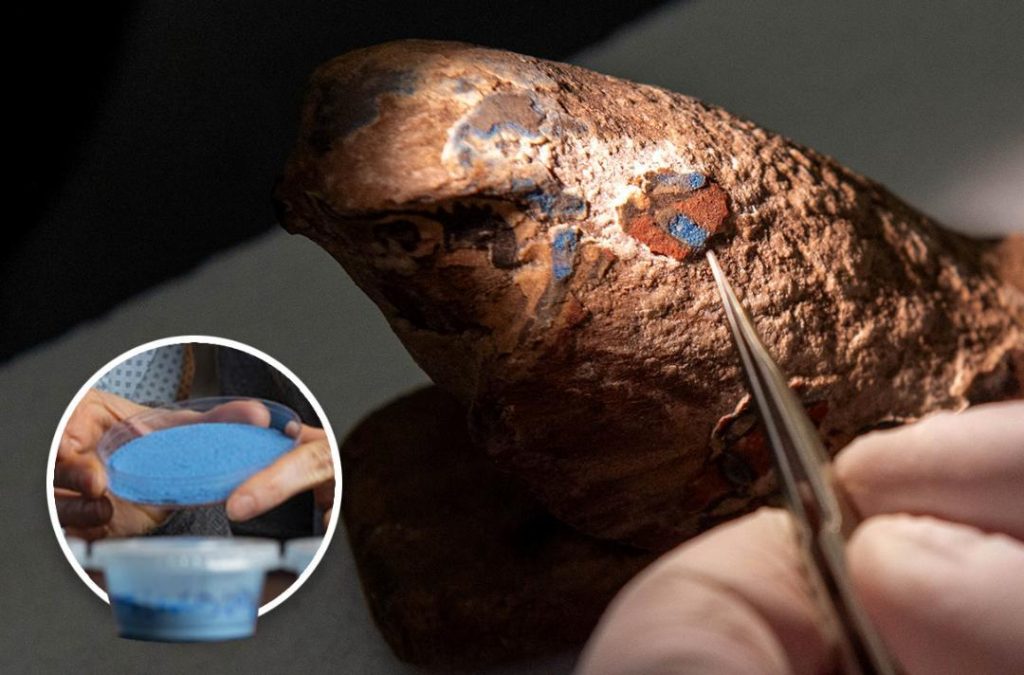
Researchers Recreate World’s Oldest Synthetic Pigment Egyptian Blue
For centuries, the artistic and cultural significance of Egyptian blue has been a topic of fascination for historians, art enthusiasts, and scientists alike. This ancient pigment, which dates back over 5,000 years, was a vital component in the artistic endeavors of the ancient Egyptians, Greeks, and Romans. Its unique blue hue added a touch of elegance and sophistication to various forms of art, from pottery to temple paintings. Despite its importance, the exact recipe for Egyptian blue remained a mystery until recently. Thanks to a groundbreaking collaboration between researchers from Washington State University and the Smithsonian Institution, the world’s oldest synthetic pigment has been recreated.
The journey to recreate Egyptian blue began with a thorough examination of ancient texts and archaeological findings. The research team scoured through ancient Egyptian and Greek manuscripts, as well as excavated artifacts, to gather information about the pigment’s composition and production process. They discovered that Egyptian blue was made from a combination of silicon dioxide, copper, calcium, and sodium carbonate. However, the exact proportions of these ingredients and the heating times required to produce the pigment remained unclear.
To tackle this challenge, the researchers created 12 different recipes using the identified ingredients. They varied the proportions of silicon dioxide, copper, calcium, and sodium carbonate, as well as the heating times, to observe how these changes affected the final product. The team employed a combination of analytical techniques, including X-ray fluorescence, scanning electron microscopy, and energy-dispersive spectroscopy, to analyze the physical and chemical properties of each recipe.
After conducting a series of experiments and analyzing the results, the researchers were able to identify the optimal recipe for Egyptian blue. Their findings revealed that the pigment’s unique blue color was achieved by heating a mixture of silicon dioxide, copper, and calcium at a high temperature (around 900°C) for several hours. The addition of sodium carbonate played a crucial role in stabilizing the pigment’s color and preventing it from degenerating over time.
The recreated Egyptian blue exhibits a vibrant, sky-blue color with a slight turquoise undertone. Its light-fastness, meaning its ability to resist fading when exposed to light, is exceptional, making it an ideal choice for artistic applications. The researchers’ successful recreation of Egyptian blue is a testament to their dedication and attention to detail.
Egyptian blue was highly valued during ancient times due to its rarity and the complexity of its production process. The pigment was often used to create vivid blue hues in art, architecture, and decorative objects. Its significance extended beyond its aesthetic appeal, as it was also used in religious and cultural practices. For instance, Egyptian blue was used to adorn the walls of temples and tombs, symbolizing the connection between the earthly and divine realms.
The recreation of Egyptian blue has significant implications for the fields of art conservation, restoration, and education. By having access to the original pigment, conservators and restorers can now accurately replicate the colors used in ancient art, ensuring the preservation of cultural heritage for future generations. Moreover, art historians and enthusiasts can gain a deeper understanding of the artistic techniques and cultural significance of Egyptian blue.
The recreation of Egyptian blue is also a testament to the power of interdisciplinary collaboration and the importance of preserving cultural heritage. The researchers’ work highlights the value of combining scientific expertise with historical knowledge and cultural sensitivity. As we continue to uncover the secrets of the past, it is essential that we approach these discoveries with respect, care, and a commitment to preserving our cultural legacy.
In conclusion, the recreation of Egyptian blue is a groundbreaking achievement that has shed new light on the artistic and cultural practices of ancient civilizations. The researchers’ dedication to recreating this ancient pigment has not only advanced our understanding of its composition and production process but also provided a valuable tool for the preservation and restoration of cultural heritage. As we continue to explore the mysteries of the past, we must remain committed to preserving our cultural legacy and honoring the artistic and cultural achievements of those who came before us.
Source:
https://news.wsu.edu/press-release/2025/06/02/researchers-recreate-ancient-egyptian-blues/






